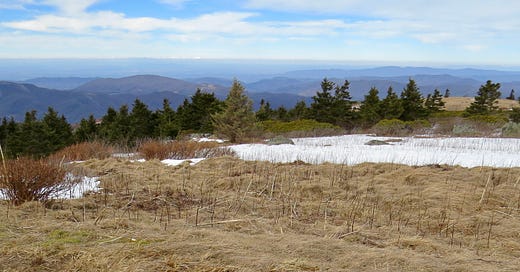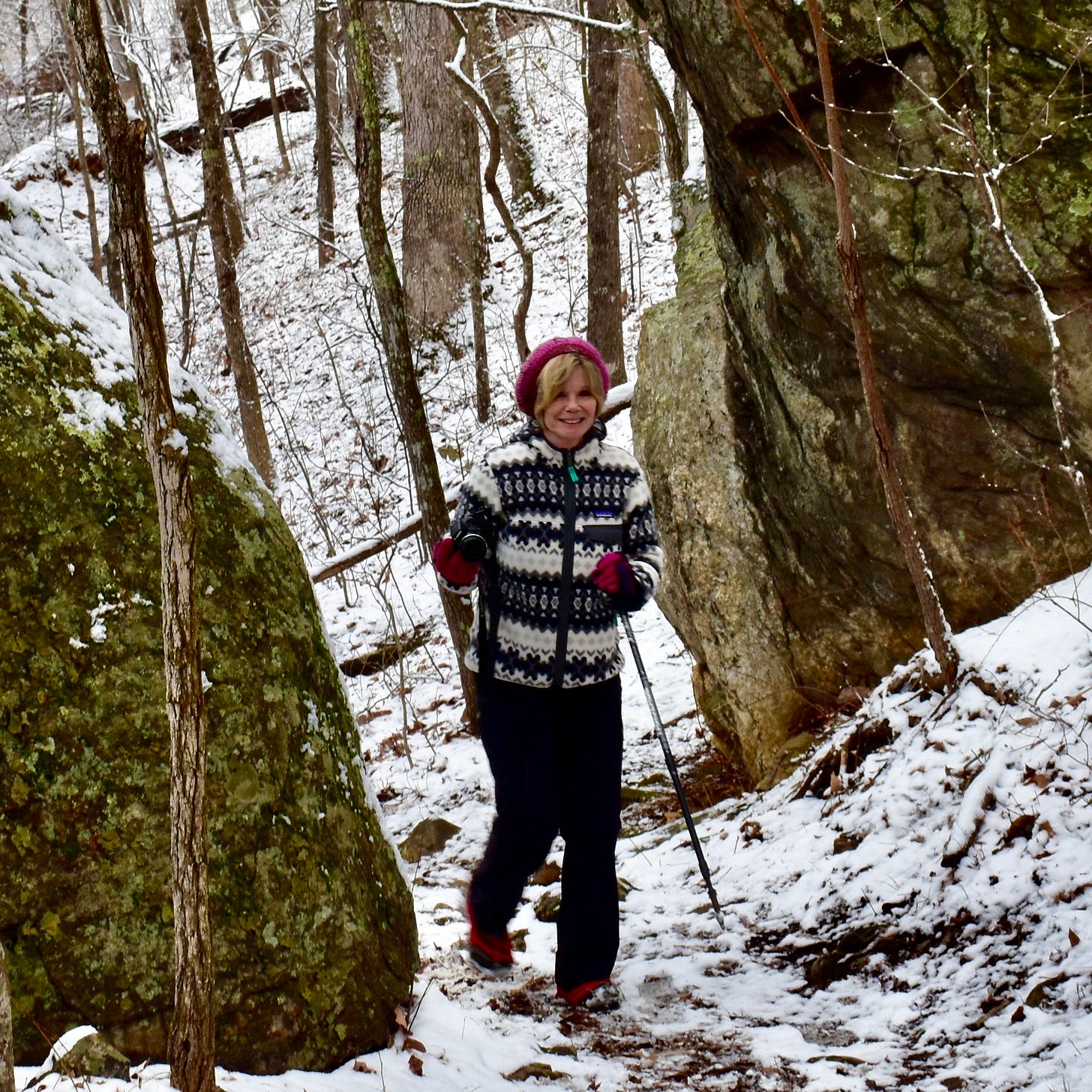Story Frame 72 – My Side of the Mountains: Flowers of Darkness & Appalachian Poetry
After a few years in Asheville, I noticed a shift taking place in the films coming my way. It was as if I’d caught up with the storyframes and we were now working through issues, ideas and healing side by side, instead of me simply following their lead. I loved this surprising new sense of interplay, and the feeling that the films and I had an effect on each other.
Looking back, I think it began when I was invited to help launch a new PBS series, Appalachia: A History of Mountains and People.
The title brought back memories of one of my favorite childhood books, My Side of the Mountain by Jean Craighead George. It won a lot of awards and was even made the Hans Christian Andersen Award honor list in 1969, which may be why my mother was inspired to get a copy for me.
My Side of the Mountain is the story of Sam, a 12-year-old boy who so dislikes living in his parents' cramped New York City apartment with his eight siblings, he runs away to the Catskill Mountains to live in the wilderness. Using survival skills learned from a book he borrowed from the New York Public Library, Sam traps animals for food and forages for edible plants. He lives in a hollowed out tree with his pets – a Peregrine falcon and a weasel. When his clothes wear out, he fashions deerskin clothing from animal hides. As winter approaches, he makes storage spaces in other hollowed-out tree trunks for the fruits, nuts, wild grains, tubers, smoked fish and meat he has gathered.
Sam was my hero, and his story has always stayed with me. During the city years of my childhood, I would sometimes daydream about escaping to a life in the mountains.
That dream finally came true in 2005. By then I was 49, and old enough to appreciate that I could live in the mountains without living in a tree or catching my own food.
And now that I was living in some of the oldest mountains in the world, one of the smartest and luckiest things I did early on was to join the Asheville Hiking Group. Headed up by two new friends, Chris and Tracey, joining this group opened up a world of friendships and adventures I’d never imagined possible.
Weekends were soon filled with hikes through the mountains, along streams and rivers with picnics by some of Western North Carolina’s more than 150 waterfalls. Sometimes I brought my dogs and sometimes even Zoë and Leif when they were home. Soon, I had strong legs and a big and diverse bunch of friends.
My parents were not hikers, but they were both walkers and some of my favorite memories of both of them were the talks we had on our weekend walks – in cities, along rivers, near beaches, and in the countryside. Living the advice of Søren Kierkegaard, the Danish father of existentialism, I have been a walker all my life.
“Above all, do not lose your desire to walk,” Kirkegaard once wrote. “Every day, I walk myself into a state of well-being. I have walked myself into my best thoughts, and I know of no thought so burdensome that one cannot walk away from it ... if one just keeps on walking, everything will be all right.”
I loved the idea of walking myself into my best thoughts.
It was through hiking that I started becoming someone I hadn’t been before. To my surprise, it was someone I liked. Someone who was fit. Someone who hiked mountains. Someone who could hike mountains. Someone who was happier when hiking in the mountains. And the more I hiked, the more I healed.
Documentaries like Stranger with a Camera and other news stories and films, with their negative images of the Appalachian poor have only told part of the story. While there is some truth to them, it’s certainly not the whole story, nor the only story.
Appalachia: A History of Mountains and People gave me the opportunity to share with viewers all over the country the stories of those who live in them and an opportunity to give back something positive in return for what living in these mountains had done for me.
Ten years in the making, Appalachia: A History of Mountains and People was touted as the first environmental series about a region.
Narrated by Sissy Spacek, famous for her role playing Loretta Lynn in the film The Coal Miner’s Daughter, the series begins with the deep and surprising history of Appalachia, exploring the region's unique mosaic of plant, animal and early human life. From there, it goes on to tell stories about people who made the Appalachians home, stories of people struggling to find a true and proper relationship to the natural world, along with stories about the mountains themselves, which are treated as characters in the narrative.
Appalachia reveals that coal, so valuable to the region's economy, was created by tropical jungles compacted over millions of years. Deep underground, ghostly outlines of these ancient, petrified plants still glow on the black coal. Miners called them flowers of darkness. One acre of cove forest in the Great Smoky Mountains can support more species of trees than are found in all of Europe.
Author Barbara Kingsolver and Pulitzer Prize-winning scientist E.O. Wilson and many others weave colorful personal stories with scientific anecdotes about the region's complex ecosystem, explaining the dynamic interaction – both positive and negative – of natural history with human history.
It took Academy Award-nominated filmmaker Ross Spears and writer Jamie Ross ten years to make this epic series and I could hardly think of anything I’d enjoy working on more than the story of what was all around me. And I wasn’t the only one. We ended up with close to fifteen thousand airdates on PBS stations all over the country for this series.
Whenever a new film was released that had actually been shot in North Carolina, like The Hunger Games (2012), which was partly shot on location in DuPont State Forest, dozens of us piled into the movie theater together, each trying to be the first to identify a trail, tree or waterfall. The beers we’d had beforehand helped, or maybe didn’t help, our efforts.
Every so often, friends also organized hikes around mountain areas used in film shoots. There was my friend Glenn’s infamous Last of the Mohicans hike, an all-day hunt up and down Walker Knob (elevation 5497 feet) in search of Daniel Day-Lewis. Or rather, the actual twigs and leaves he might have run through half naked.
According to Glenn, we covered the opening scene from Last of the Mohicans, taking Elk Pen across a wide shin-deep stream, then up through an old stand of oak and poplar and across another wide wet stream. Following that, a trek up to and along Upper Corner Rock that involved a steep ¾-mile ascent. Then we hiked through Laurel Gap, stopping to admire one waterfall, a tiny swimming hole, and the nice views, before finishing the afternoon with a rocky descent on Perkins and Walker Creek Trails to end up back at the trailhead. I can still picture the entire trail in my mind, as I can with just about every other hike I did in these mountains.
Two years after Appalachia, Catherine Tatge and Dominique Lasseur from Global Village Media in New York City contacted me about working with them on their American Masters documentary, John Muir in the New World. As it was a PBS broadcast, they didn’t need my help getting it on the air. What they did want was outreach: how could they get it into classrooms and encourage kids to interact with and develop an appreciation for nature and the natural world?
I was one of just two entities they’d reached out to for a proposal. The other one suggested a full color poster that could be hung up in classrooms with getting out in nature suggestions on its backside. I didn’t understand this; if the poster was hung up on the wall, how would the kids see the activities written on its other side?
One day, driving into the parking lot at Greenlife – the natural foods grocery store where the Breaking Bad dude with the long blonde dreads worked – I saw a card table set up just outside the front door. An enthusiastic young woman was standing behind a banner that read “Muddy Sneakers.”
I’d never seen them there before but was delighted the nonprofit’s entire reason for being was to get kids outside and in nature. If I just paid attention, Asheville provided me with the inspiration and answers I needed.
Through Muddy Sneakers, I discovered the Children & Nature Network, founded by Richard Louv, an American journalist and author of several books about family, community, and nature. It was Louv who coined the term, “Nature Deficit-Disorder” –which was just what I felt I had been suffering from while living in the Washington DC suburbs.
I wanted to share my passion for being in nature with kids all over the country – not with a poster on a classroom wall, but with actual experiences, as John Muir surely would have done. Together, the team at CNN and I crafted an education packet of resources and ideas, partnered with the US Forest Service, and set up simultaneous screening parties in living rooms all over the country.
As Muir himself said, “When one tugs at a single thing in nature, he finds it attached to the rest of the world.”
As if there was some sort of geological pull in effect, more nature-themed documentaries began coming my way. I intertwined my weekdays work on them with weekend adventures hiking to places in the mountains with storytelling names like Rainbow Falls, Bridalveil, Turtleback and Linville Falls, Rattlesnake Lodge, Panthertown, Max Patch, Turkey Pen Gap, Bearwallow, Black Balsom, Unaka and Tanawah; Slate Rock and Looking Glass Rock. Just saying their names sounded like Appalachian poetry to me.
The films seemed almost to be responding to what was going on in my world. There was a new harmony and balance in my life; a sense of symmetry and wholeness I’d never before experienced.
Kristin Fellows is a published writer, world traveler, and a well-seasoned documentary film consultant. When not writing, Kristin can often be found listening to someone’s story or behind the lens of one of her cameras.
More about Kristin @ kristinfellowswriter.com







I know you have many talents and regard you as one of my favorite writer/creators. I did not know you were also a talented hiker. One of the things that contributes to your many faceted brilliance is your attention to detail. You are the perfect example of Mary Oliver's "Pay attention. Be astonished. Tell about it." And you have many good ways of telling, sharing and showing. We out here in la la land are the beneficiaries of your gifts.
Great read. Nature. Out of doors. I’m old and a walker. Fortunately for me, I did the Camino as an elder, 7, and have not stopped walking since, 83. When I hear the click of the closing door, my shoulders settle, my steps become strides and my mind opens. It’s not that the exercise is unimportant but it’s the experience I seek.